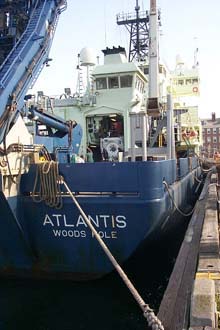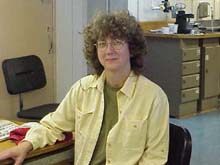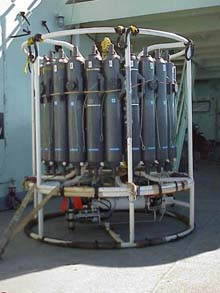
An aft (rear) view of the R/V Atlantis moored at the Woods Hole Oceanographic Institution. Click on image for larger view.
Night Owls
September 16, 2001
Tanya Podchaski, Teacher
Bernards High, Bernardsville, New Jersey
"Some love to roam o'er the dark sea's foam, where the shrill winds whistle free." -- Charles Muckay
Once the research vessel (R/V) Atlantis was out at sea, the first order of business was to get the equipment ready for the evening's events. Together, scientists and crew members prepared the CTD rosette for a 2 am launch on Monday, Sept. 17.
The CTD rosette is comprised of a large cylindrical frame that holds niskin bottles and a CTD sensor. The sensor is situated in the center of the base of the frame, while the niskin bottles are placed around the inside of the frame. The sensor records the conductivity (salinity), temperature, and depth of a certain site. This gives the scientist information about the habitat's physical parameters.
Niskin bottles (narrow, cylindrical, 1-m-long plastic tubes capped at both ends) are used to collect water samples from different depths. The CTD rosette contains 24 of these 10-liter bottles. Before the CTD is lowered into the ocean, the caps on both ends of each bottle are cocked. This allows the sea water to enter the bottles. The scientist can then trigger them to shut at different depths to obtain a series of samples.
The CTD is lowered into the water off the side of the research vessel on a winch attached to a steel boom. The boom extends over the side to launch the CTD, and retracts when the apparatus returns to the surface. The entire process of lowering and raising the rosette takes several hours when it is lowered to a depth of 2,640 m.
The planned 2 am launch time came and went. The R/V Atlantis was having a hard time sticking to its position. The wind, waves, and current were all moving in different directions, causing the vessel to move away from the launch site. We tried again at 3 am, but it was still too dangerous to launch. Around 4:20 the decision was made not to launch the CTD this morning. Tired scientists then made their way down to their bunks to salvage some sleep. We'll try again tomorrow!
(top)

These specially designed traps isolate the shrimps and crabs inside from light and elevated water temperatures as they are brought to the surface. Click image for larger view.
Chemical Oceanographer
State University of New York at Stony Brook
Ocean Explorer Team: What is the focus of your research on the Deep East Expedition?
Mary Scranton: Methane seeping from the ocean floor and measuring the amount of methane in the water column.
Ocean Explorer Team: What is the importance of studying methane in the oceans?
Mary Scranton: There are four main things that methane can tell us. First, we are looking for any biological activity around the seeps. Some clams and other organisms have been found around methane seeps. Second, the energy companies are interested in the methane, because it could be another source of energy on land. Third, methane is thought to destabilize sediments on the ocean floor. Therefore, methane is thought to be a mechanism for slumping along the continental slope. Finally, methane from the oceans might have an impact on global warming. Usually, organisms in the water help consume the methane gas. If a large bubble of methane were released, it could affect the atmosphere.
Ocean Explorer Team: What kind of information do you wish to obtain from the CTD rosette?
Mary Scranton: We are looking to see if there are any traces of methane in the water column. If we find traces of methane, then we can hypothesize that a methane seep exists nearby.
Ocean Explorer Team: What is a methane seep?
Mary Scranton: It is a cold stream of methane gas and water that is released through the ocean sediments. We are guessing that the seep originates from deep methane gas reservoirs beneath the ocean sediments.
Ocean Explorer Team: How does your upcoming dive compare to others you have done?
Mary Scranton: I have only been on one other submersible. I was on the NR-1, which is the U.S. Navy's nuclear research sub. It had 11 crew members and was capable of staying down for as long as to 30 days (I was the first woman to stay on it overnight!). It was mainly a search-and-rescue sub. So this is a new experience, and I am a little nervous.
Interview by Caren A.D. Menard of the Ocean Explorer Team.
Sign up for the Ocean Explorer E-mail Update List.

































